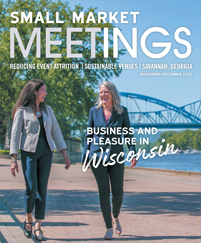Cendyn, a global integrated hotel technology and services company, and ConferenceDirect, a full-service global meetings solution company, recently released their annual report, 2025 State of the Meetings Industry. The collaboration, paired with Knowland by Cendyn data, reveals insights to help industry professionals understand what meeting planners and event managers expect and will prioritize in 2025.
In the past year, the landscape of meetings has been evolving in unexpected ways. Smaller meetings dominated in 2024, but 2025 is ushering in a resurgence of medium and larger gatherings, signaling a strong comeback for larger events. At the same time, planners have had to adapt quickly, with nearly half of bookings made for events happening within the same year. But a shift is underway — more organizations are looking ahead, with a growing number of meetings being scheduled three to five years in advance.
Other highlights include:
- Medium and large-sized meetings strike a balance — Meetings with 100 to 250 attendees represented 35.8% of all bookings in the U.S., while events with over 500 attendees accounted for 32.4%. During the year, 49.4% of bookings were made in the year for the year. However, booking windows are lengthening as 9.5% of meetings booked were 3-5 years in advance. This trend shows an equalizing shift between smaller and larger events, emphasizing the need for hoteliers to improve services and amenities tailored to diverse group sizes. By focusing on both medium-sized meetings (100 to 250 attendees) and larger ones (over 500 attendees), hoteliers can take advantage of this balanced market.
- Rising costs continue to be a top area of dissatisfaction — Planners are dissatisfied with rising costs, which has strained budgets and affected the quality of events. Cost-cutting measures, such as shorter meetings, alternative destinations and reduced activities or food and beverage options, must be managed effectively to avoid compromising the attendee experience.
- Secondary markets are becoming more favorable — Companies may consider changing destinations and venues to manage meeting costs. Groups are more likely to relocate events to secondary markets to maintain event quality and/or status and avoid moving down in chain scale. This shift presents opportunities for secondary and tertiary markets to attract new business by offering quality products, services and attractive pricing alternatives compared with the top 25 market destinations.
- Audiovisual support and F&B are preferred RFP add-ons — Planners seek proposals that clearly define technological capabilities and catering options despite prices trending upward. 60% of planners report advanced AV support as a top priority with 33% indicating that technology-enabled events are top of mind. More than 53% of respondents prefer that catering in RFP responses emphasize functionality and hospitality.
“It is an exciting time to be a part of the meetings and event industry,” said Michael Bennet, president of Cendyn. “The outlook for 2025 is optimistic, with more than 40% of meeting planners expecting bookings to increase and 65% anticipating higher attendance even as rising costs remain a significant challenge for planners. Finding a balance between high costs and delivering an amazing customer experience will define winning venues in 2025. We look forward to enabling our customers to make every guest interaction an opportunity to nurture relationships and maximize profitability.”
“We have seen a rise in secondary markets as popular destinations, with 90% of planners considering them a cost-saving alternative,” said Larry Hanson, CMO of ConferenceDirect. “That being said, planners will prioritize venues capable of making a lasting impression. Respondents emphasized that there is little room for compromise regarding event quality and the pressure is on to deliver exceptional attendee experiences.”
Download the 2025 State of the Meetings Industry here.












